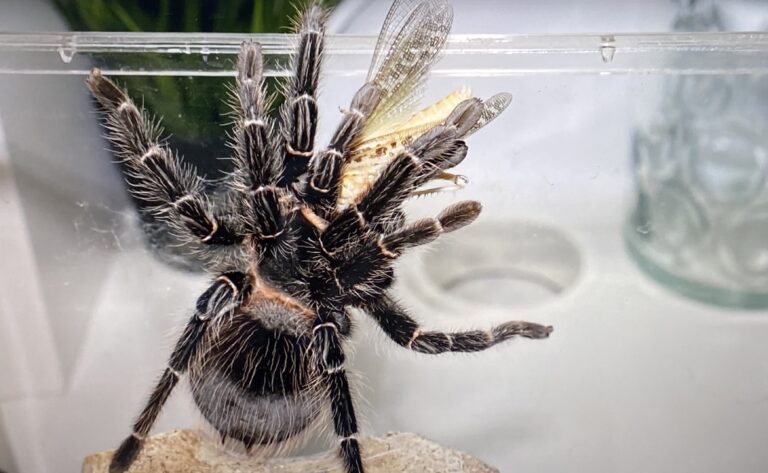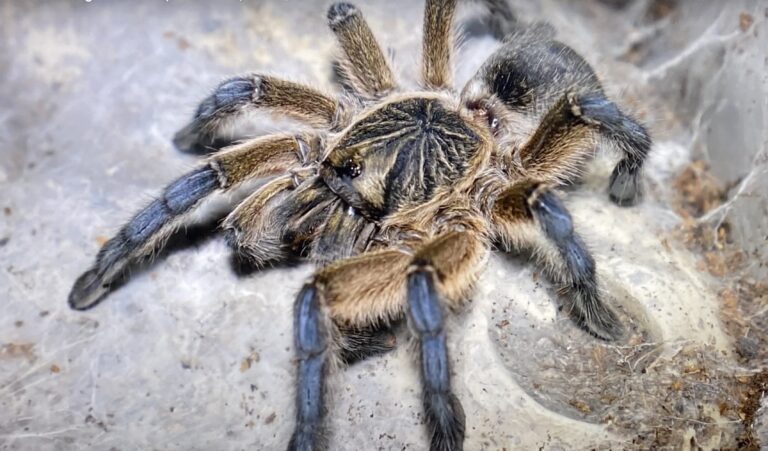Feeding a Tarantula: A Comprehensive Guide for New Tarantula Owners
A proper diet allows tarantulas to grow and thrive, no matter if it’s in the wild or a pet in captivity. Feeding a tarantula is one of the most commonly discussed aspects of spider care, especially for those who are new to keeping this type of pet. As tarantulas are carnivores, many people expect them to have complicated dietary needs, but this isn’t the case.
Tarantulas, in general, are not fussy eaters. If an opportunity for a good meal presents itself, a tarantula in the wild is likely to take it. This is best displayed by female tarantulas; females will rarely go far from their hides to hunt, so if the movement of an insect or other small animal is sensed, she will quickly exit her burrow to capture her prey. Ground-dwelling tarantulas will often have webbing around the entrance of their home, too. This serves as a trip wire to alert the arachnid of a passing meal.
But what can you feed a tarantula? As a tarantula owner, this is essential information, and this article aims to provide advice on the best tarantula diet.
What Do Tarantulas Eat?
As opportunistic hunters, tarantulas can eat a variety of live insects, such as crickets, roaches, smaller spiders, and worms. Although all of these insects can be sourced from reputable pet stores, it is important to know that worms can be rather fatty. For this reason, they should not be a regular food source for pet tarantulas. It is also best to only feed one worm at a time and monitor it. This is a precautionary measure as many worm species will eventually pupate into beetles that could be a danger to the spider and its enclosure.
Just like their wild counterparts, pet tarantulas eat almost everything they are provided with. For pet tarantulas, gut-loading feeder insects are important. This is the process of feeding the prey insects a

nutritious diet that will satisfy the arachnid when it eats the insects. To gut load insects, you can purchase liquids or pastes, or you could even create your own formula like the one found here. A mixture like this should be fed to the insects a few hours before they are given to the tarantula. This helps to ensure the tarantula receives all of the vitamins it needs, including vitamins A and E, omega-3 and 6, and beta-carotene.
Some tarantula owners also feed their arachnids frozen pinkie mice and live small frogs, lizards, and snakes. These prey animals, as well as the insects, should be smaller than the tarantula to ensure safe feeding. The frozen pinkie mice might require feeding tongs to feed the tarantula as it will be relying on movement for a successful hunt.
Best Feeder Insects for Feeding a Tarantula
Although it can slightly differ between species of tarantulas and their preferences, most will do well on the same feeders. The four options shown below are considered to be some of the best feeder insects:
Crickets
Crickets are one of the most common feeders, but they can be especially good for arboreal tarantulas. This is because crickets will move around a lot in the enclosure and grab the tarantula’s attention. They come in all different sizes, meaning they can be suitable for slings to adult tarantulas. Crickets are also highly nutritious, providing biotin, niacin, vitamins A and E, and more, all of which support the tarantula’s body functions.
Feeding a molting tarantula isn’t recommended, and insects such as crickets are a good reason why not. These insects can bite and even eat a molting tarantula, so it is best to avoid feeding your tarantula completely as it molts.
Dubai Roaches
Although tarantulas can eat several types of roaches, including Madagascar hissing roaches, dubia roaches are arguably the best choice. These roaches are good all-rounders; they are unlikely to harm a tarantula during a molt and provide large amounts of nutrients. They are also easy to breed, which can save tarantula owners some money in the long run.
Super worms
Superworms can be a cheaper and less smelly alternative feeder to crickets and dubia roaches. Their nutritional value can be increased by gut loading and dusting with calcium prior to feeding.
Like most worms, superworms dig and pupate into beetles and can harm tarantulas. Tarantula keepers are encouraged to crush the worm’s head prior to feeding to stop it from burrowing or injuring the tarantula. As previously mentioned, the best way to safely feed superworms to a tarantula is to feed one at a time and monitor the situation. This provides an opportunity to remove the uneaten worm if required.
Hornworms
Hornworms are among the more expensive feeders. Despite the word “worm” in their name, hornworms are actually caterpillars. As moths, they can be an excellent feeder for an arboreal tarantula. Growing to almost four inches long and becoming quite fat, hornworms are good sources of hydration. They are best used as an occasional meal due to how much they can cost.
Also, only hornworms bred in captivity should be used as feeders. Wild hornworms can become contaminated by feeding off various plants, which can be fatal to arachnids. As for tarantula owners in the UK, hornworms are not a feeder option as they are not allowed in the country. This is due to the hornworms being considered pests.
How Often Should You Be Feeding a Tarantula?
The frequency of feeding a tarantula often depends on its age, growth rate, and species. As tarantulas grow, they expel more energy, which means they require more feedings. Most molts take place during the sling and juvenile stages of life, so younger tarantulas should be given food every day or two. Adult tarantulas should only need to be fed once a week or so.
Similarly, if a tarantula species is known to be slow-growing, then it should not require frequent feedings. For example, Mexican Golden Rump tarantulas (Brachypelma albiceps) typically eat once or twice a week as adults. However, if you are unsure how often to feed your pet tarantula, contacting a vet with arachnid experience is encouraged.

Feeding a tarantula on a consistent schedule can help to avoid tarantulas being under or overfed. Tarantulas are not domesticated, and it can be weeks or months before prey walks by, so their size can fluctuate. The general rule is less is more when feeding tarantulas. However, if the abdomen appears shrunken and shriveled, then the tarantula is likely dehydrated.
